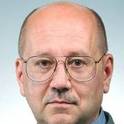Scanning probe microscopy (SPM) images can be obscured by signals from blunt and multiple probe tips. We show why crystallographic image processing (CIP) techniques may be utilized to restore obscured images that are periodic in two dimensions. The image‐forming current for double tips in scanning tunneling microscopy (STM) is derived in a more straightforward manner than prior approaches. The Fourier spectrum of the tunneling current for p4mm Bloch surface wave functions and a pair of delta function tips reveals the tip‐separation dependence. Our analysis clarifies why crystallographic averaging works well in removing such effects from the recorded 2D periodic images and also outlines the limitations of this image processing technique for certain spatial separations of STM double‐tips. Classical simulations of double tip effects in STM images (that ignore electron interference effects) may be understood as modeling double tip effects in images that were recorded with other types of SPMs. Appendix A demonstrates how double tip effects on scanning probe microscope images are detected unambiguously.
Article
Double-Tip Effects on Scanning Tunneling Microscopy Imaging of 2d Periodic Objects and Limits of Their Removal by Crystallographic Averaging in The Spatial Frequency Domain
Crystal Research & Technology
Document Type
Citation
Publication Date
2-1-2014
Disciplines
Abstract
Locate the Document
DOI
10.1002/Crat.201300240
Persistent Identifier
https://archives.pdx.edu/ds/psu/25897
Citation Information
Straton, J. C., Bilyeu, T. T., Moon, B., & Moeck, P. (2014). Double‐tip effects on scanning tunneling microscopy imaging of 2D periodic objects: unambiguous detection and limits of their removal by crystallographic averaging in the spatial frequency domain. Crystal Research and Technology, 49(9), 663-680.

© 2014 WILEY‐VCH Verlag GmbH & Co. KGaA, Weinheim